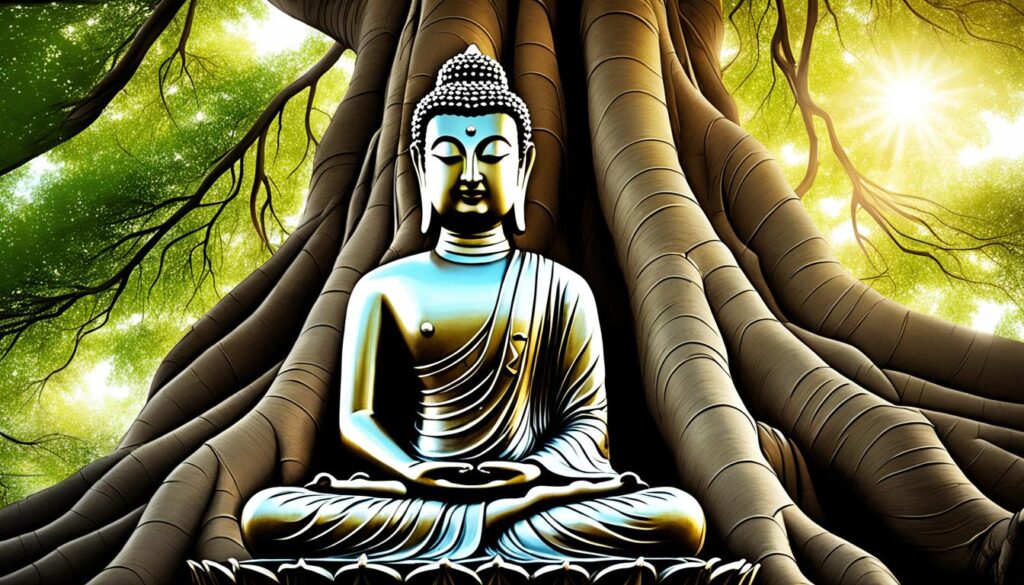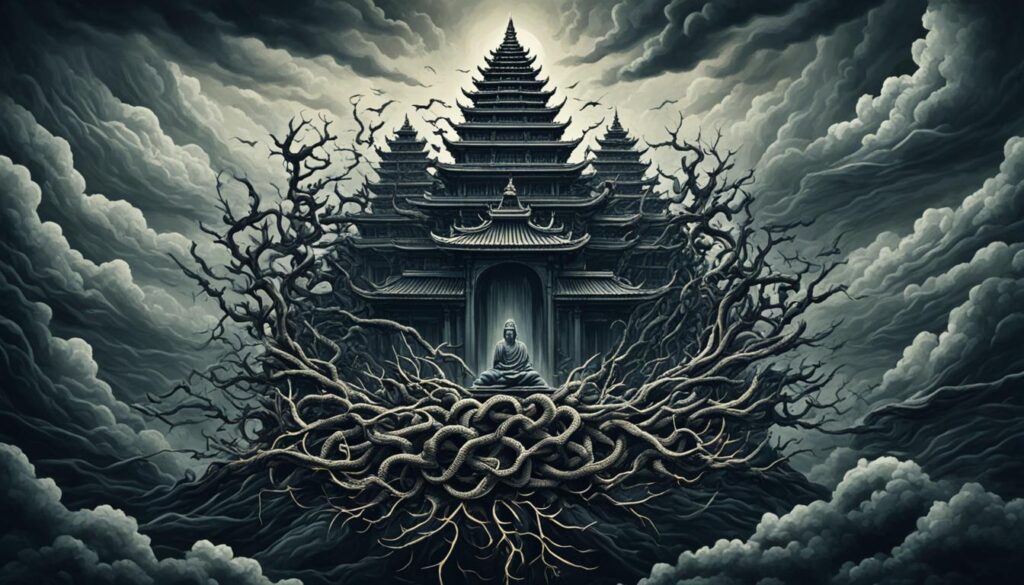Have you ever wondered why suffering exists? Is there a way to find lasting peace and freedom in the midst of life’s challenges? These profound questions lie at the heart of Buddhism, a spiritual tradition that offers profound insights into the nature of suffering and the path to liberation.
In this article, we will explore the Four Noble Truths, the foundational teachings of Buddhism. These truths reveal the essence of suffering, its cause, and the path towards attaining true liberation. Join us on this transformative journey as we delve into the wisdom of the Buddha and discover the profound truths that have guided millions of seekers for centuries.
Key Takeaways:
- The Four Noble Truths form the cornerstone of Buddhist teachings.
- The First Noble Truth recognizes that suffering is an inherent part of life.
- The Second Noble Truth reveals that craving and attachment are the root causes of suffering.
- The Third Noble Truth offers hope by proclaiming that the end of suffering is possible.
- The Fourth Noble Truth outlines the Eightfold Path as the way to liberation from suffering.
The First Noble Truth: Life is Suffering
In Buddhism, the First Noble Truth is a fundamental concept that forms the cornerstone of the teachings. It proclaims that life is inherently filled with suffering, encompassing various forms of pain and dissatisfaction.
The recognition of suffering in Buddhism goes beyond physical pain. It acknowledges the existence of emotional distress, existential dissatisfaction, and the impermanent nature of our lives. This truth is not meant to discourage or despair, but rather to bring awareness to the realities of human existence.
Suffering arises from the inevitable fluctuations and challenges we encounter throughout our lives. From birth to old age, we face physical ailments, loss, and the untangling of relationships. Emotionally, we grapple with grief, anxiety, and uncertainty. The existential dimension of suffering emerges from a sense of disconnection, a longing for meaning, and the recognition of the impermanence of all things.
By acknowledging the First Noble Truth, we open ourselves to the transformative potential of the Buddhist path. It invites us to explore the depths of human experience and seek understanding in the face of suffering. It is through this recognition that we can embark on a journey towards liberation and find true peace and contentment.

The Second Noble Truth: The Cause of Suffering is Craving
In Buddhism, the Second Noble Truth unveils a profound insight into the origin of suffering. It teaches that the root cause of suffering is craving and attachment. According to the teachings of Buddhism, our desires and attachments lead to a perpetual cycle of dissatisfaction and suffering.
Craving can take various forms, from desire for material possessions, fame, and power to attachment to relationships, ideas, and even our own identities. These cravings create a sense of lack within us, perpetuating a never-ending quest for fulfillment that can never be truly satisfied.

To overcome this cycle of suffering, Buddhism proposes that we recognize and let go of our cravings and attachments. By cultivating awareness of these desires and developing the ability to detach from them, we can achieve freedom from suffering.
Paths to Freedom: Letting Go and Liberation
Letting go is not about suppressing or denying our desires, but rather adopting a mindset of non-attachment. It involves understanding that the impermanence of all things prevents any lasting satisfaction from being derived from them. By releasing our grip on what we crave and realizing that all things are transient, we can find liberation from suffering.
The End of Craving, The End of Suffering
Buddhism holds that the end of suffering is achievable by eliminating craving entirely. By uprooting the causes of suffering at their core, practitioners can attain a state of complete freedom known as Nirvana.
In this state of liberation, one transcends the limitations of craving and attachment, experiencing profound peace, contentment, and inner freedom. Nirvana is not only the cessation of suffering but also the realization of true happiness and enlightenment.
To summarize, the Second Noble Truth of Buddhism teaches that craving and attachment are the causes of suffering. By recognizing and letting go of these cravings, one can achieve freedom from the perpetual cycle of dissatisfaction and find true liberation from suffering.
The Third Noble Truth: The End of Suffering Comes with an End to Craving
When we look at the Four Noble Truths, the Third Noble Truth offers a glimmer of hope amidst the recognition of suffering. It tells us that the end of suffering is not an unattainable dream, but a real possibility within our reach. According to Buddhism, the key to ending suffering lies in letting go of craving and attachment.
Craving is the root cause of our suffering. It is our intense desire for things to be different from what they are, our relentless pursuit of pleasure, and our aversion to pain. By clinging onto these desires and attachments, we perpetuate a cycle of dissatisfaction and suffering.
To break free from this cycle, we must learn to let go. We must cultivate a mindset of non-attachment, embracing the impermanence of all things and understanding that our desires can never bring lasting satisfaction. Through this process of relinquishing cravings, we can achieve a state of liberation known as Nirvana.
Nirvana is often misunderstood as a state of eternal bliss or paradise. In reality, it is the cessation of suffering and the realization of true peace and freedom. It is a state of mind where one is no longer driven by desires and attachments, but instead experiences a deep sense of contentment, clarity, and interconnectedness.
The journey towards ending suffering begins with self-reflection and self-awareness. It requires us to examine our desires and attachments, to understand their root causes, and to cultivate the courage to let them go. By practicing mindfulness and embracing the present moment, we can gradually reduce our cravings and find liberation from suffering.
The Liberating Power of Letting Go
Letting go does not mean becoming indifferent or detached from life’s experiences. It means cultivating a deep sense of acceptance and non-clinging, allowing life to unfold naturally without resistance. It means embracing the beauty of impermanence and finding contentment in the present moment.
When we let go of craving and attachment, we free ourselves from the constant cycle of seeking happiness outside of ourselves. We realize that true happiness comes from within, from a state of inner peace and self-acceptance. We no longer rely on external circumstances or material possessions to define our happiness, but instead find joy in the simplicity of life.
The Third Noble Truth reminds us that the end of suffering is within our reach. By letting go of craving and attachment, we can break free from the chains that bind us and open ourselves to a life of peace and freedom. It is a transformative journey that requires dedication, practice, and self-reflection, but the rewards are immeasurable.
Next, we will explore the Fourth Noble Truth, which introduces the path to freedom from suffering. Through the Eightfold Path, we can cultivate a way of life that leads to liberation and the realization of our full potential.

The Fourth Noble Truth: The Path to Freedom from Suffering
The Fourth Noble Truth introduces the Eightfold Path as the way to overcome suffering. This path consists of eight interconnected principles that serve as a guide for living a meaningful and liberated life. By following the Eightfold Path, individuals can cultivate a way of life that leads to liberation from suffering.
The Eightfold Path
The Eightfold Path encompasses various aspects of life and provides a holistic approach to spiritual development and the attainment of enlightenment. Each aspect of the path plays a crucial role in the journey towards liberation:
- Right View: This involves developing a correct understanding of life, suffering, and the nature of reality.
- Right Intention: It focuses on cultivating wholesome intentions and aligning one’s actions with the pursuit of liberation.
- Right Speech: This emphasizes the importance of using words that are truthful, kind, and beneficial to oneself and others.
- Right Action: It involves engaging in ethical conduct and abstaining from actions that cause harm and suffering.
- Right Livelihood: This entails earning a living through means that are righteous, compassionate, and in harmony with the Eightfold Path.
- Right Effort: It refers to the commitment and perseverance needed to overcome unwholesome mental states and cultivate wholesome qualities.
- Right Mindfulness: This involves developing mindful awareness of one’s body, feelings, thoughts, and the present moment.
- Right Concentration: It refers to the cultivation of deep concentration and focused meditation, leading to insight and the realization of enlightenment.
By following the Eightfold Path, individuals can gradually transform their thoughts, speech, and actions, leading to a harmonious and fulfilled life free from suffering. It is a comprehensive guide that encompasses the different aspects of human existence, enabling individuals to make meaningful choices and progress on their spiritual journey.
Image

Buddha’s Enlightenment and the Four Noble Truths
The Four Noble Truths were envisioned by Siddhartha Gautama, who later became known as the Buddha, during his quest for enlightenment. After experiencing the sights of suffering, old age, sickness, and death, Siddhartha realized the nature of suffering and its causes. Underneath a Bodhi tree, he attained enlightenment and discovered the Four Noble Truths.

| Key Points | Details |
|---|---|
| Siddhartha Gautama | Buddha, the founder of Buddhism, originally known as Siddhartha Gautama |
| Bodhi Tree | The place where Siddhartha attained enlightenment and discovered the Four Noble Truths |
| Source of Inspiration | Direct experience of suffering inspired Buddha’s journey towards enlightenment |
| Realization of Suffering | Buddha recognized the pervasive nature of suffering in the world and sought to understand its causes |
| Discovery of Four Noble Truths | Through deep introspection, Buddha discovered the Four Noble Truths as the pathway to liberation from suffering |
Underneath the Bodhi tree, Siddhartha Gautama embarked on a profound journey of self-discovery and awakening. It was during this transformative period that he comprehended the essence of suffering and its origin. Through his insights and contemplation, he formulated the Four Noble Truths as a means to liberate oneself from the cycle of suffering.
The Three Forms of Craving and Attachment
In the Second Noble Truth, Buddhism identifies three primary forms of craving and attachment that contribute to suffering:
- Craving for Sensual Pleasures
- This form of craving involves an intense desire for sensory experiences and the pursuit of pleasure through the senses.
- This form of craving stems from the desire for a particular identity, status, or existence in the world. It drives individuals to strive for success, recognition, and power.
- This form of craving arises from a deep aversion to pain and suffering. It leads individuals to seek escape or oblivion, hoping to avoid or eradicate negative experiences.
These attachments keep individuals trapped in the cycle of suffering, hindering their path to liberation. By understanding and gradually letting go of these cravings, one can move closer to experiencing freedom from suffering.
Forms of Craving and Attachment
| Forms of Craving and Attachment | Description |
|---|---|
| Craving for Sensual Pleasures | Intense desire for sensory experiences and pursuit of pleasure through the senses. |
| Craving for Existence or Becoming | Desire for a particular identity, status, or existence in the world. |
| Craving for Non-Existence or Annihilation | Aversion to pain and suffering, seeking escape or oblivion. |
Note: The forms of craving and attachment listed in the table are interrelated and can manifest in various ways in an individual’s life.

Understanding Dukkha: The First Noble Truth Explained
The First Noble Truth, Dukkha, is a fundamental concept in Buddhism that highlights the recognition of suffering in all its forms. It goes beyond physical pain to include emotional distress, dissatisfaction, and the impermanence of life itself. The Buddha emphasized the universality of suffering and the imperative need to address it on both personal and societal levels.
Suffering, or Dukkha, can manifest in various ways throughout our lives. It could be experienced as the pain of losing a loved one, the anguish of unfulfilled desires, or the anxiety caused by the constant fluctuations of life. By acknowledging the existence and pervasive nature of suffering, we can begin to explore its causes and work towards alleviating it.
In Buddhism, it is believed that suffering arises from our attachments and cravings. Our persistent desire for what is pleasurable and our aversion to what is not leads to a cycle of unsatisfied yearning and dissatisfaction. The pursuit of temporary pleasure and the resistance to inevitable change contribute to our suffering.
The First Noble Truth invites us to examine our own lives and recognize the presence of suffering. This recognition, rather than being pessimistic or negative, serves as a starting point for self-reflection and growth. By acknowledging and accepting the reality of suffering, we can cultivate compassion, wisdom, and a profound desire for liberation from this universal human condition.

| Key Points | Explanation |
|---|---|
| Suffering in all its forms | Dukkha encompasses physical pain, emotional distress, dissatisfaction, and the impermanence of life. |
| Recognition and acceptance | By acknowledging the reality of suffering, we can begin to address it and seek liberation. |
| Suffering and attachments | Suffering arises from our cravings and attachments, leading to an endless cycle of unsatisfied desires. |
| Compassion and wisdom | Recognizing suffering cultivates compassion, wisdom, and a profound desire for liberation. |
Understanding the First Noble Truth is the first step towards liberation from suffering. By embracing the truth of Dukkha and exploring its causes, we can embark on a transformative journey towards inner peace and true freedom from suffering.
The Middle Way: Finding Freedom from Suffering
Now that you have a deeper understanding of the Four Noble Truths, let’s dive into the Fourth Noble Truth, which reveals the path to finding true freedom from suffering. This path is known as the Middle Way.
The Middle Way teaches us to navigate between two extremes: extreme indulgence and extreme asceticism. It encourages a balanced approach to life, where we neither excessively indulge in sensual pleasures nor deny ourselves of basic needs.
This balanced approach is crucial because both extreme indulgence and extreme asceticism can lead to suffering. Indulging in sensual pleasures without restraint eventually brings dissatisfaction and attachment, creating more suffering. On the other hand, extreme asceticism and self-denial can lead to physical and mental deprivation, causing unnecessary hardship.
The Middle Way guides us towards a path of moderation. It encourages us to enjoy life’s pleasures mindfully, without clinging to them, while also recognizing that everything is impermanent. By cultivating this balanced mindset, we can let go of attachment and aversion, reducing suffering in our lives.
Central to the Middle Way is the Eightfold Path, which serves as a practical guide for finding freedom from suffering. The Eightfold Path encompasses eight interconnected principles that cover various aspects of life:
- Right View: Developing an understanding of the nature of reality and the causes of suffering.
- Right Intention: Cultivating wholesome intentions, free from selfishness and harmful desires.
- Right Speech: Speaking truthfully, kindly, and with mindfulness, avoiding harmful speech.
- Right Action: Engaging in actions that promote peace, compassion, and ethical conduct.
- Right Livelihood: Choosing a profession that aligns with moral values and contributes positively to society.
- Right Effort: Cultivating the energy and commitment to overcome negative states of mind and develop positive qualities.
- Right Mindfulness: Cultivating present-moment awareness, observing our thoughts, feelings, and sensations without judgment.
- Right Concentration: Cultivating deep concentration and mental stability through practices like meditation.
By applying these principles in our daily lives, we gradually diminish the causes of suffering and move closer to liberation. The Eightfold Path, in conjunction with the Middle Way, provides a transformative roadmap to end suffering and find lasting peace.

As you embark on your own journey to end suffering and find liberation, remember that it is a gradual process requiring patience, self-reflection, and consistent practice. The teachings of the Four Noble Truths and the Middle Way can guide you on this transformative path, leading you to discover profound freedom and inner peace.
Conclusion
The Four Noble Truths provide a profound framework for understanding and addressing suffering within Buddhism. These timeless teachings offer guidance on how to navigate the complexities of life and find liberation from suffering. By recognizing the reality of suffering, you open the door to deeper self-awareness and empathy for others.
Understanding the causes of suffering, particularly the role of craving and attachment, allows you to break free from the cycle of dissatisfaction. It empowers you to let go of unhealthy desires and attachments, paving the way for true freedom and inner peace.
Realizing the possibility of the cessation of suffering is a ray of hope that shines through the darkness. It reminds you that suffering is not permanent and that there is a path towards liberation. By following the Eightfold Path, you can cultivate mindfulness, ethical conduct, and wisdom, leading you towards the ultimate goal of enlightenment.
With the guidance of the Four Noble Truths, you can embark on a transformative journey. This journey goes beyond mere intellectual understanding and transcends into direct experience. It is a journey that invites you to embrace life in all its facets, to fully engage with the present moment, and to discover true inner peace and understanding. May your exploration of the Four Noble Truths illuminate your path towards freedom from suffering.
FAQ
What are the Four Noble Truths of Buddhism?
The Four Noble Truths are the foundational tenets of Buddhism that reveal the nature of suffering, its cause, and the path towards liberation.
What is the First Noble Truth?
The First Noble Truth states that life is inherently filled with suffering, including physical pain, emotional distress, and existential dissatisfaction.
What is the Second Noble Truth?
The Second Noble Truth explains that the root cause of suffering is craving and attachment, which leads to endless cycles of dissatisfaction.
Is the end of suffering possible?
Yes, the Third Noble Truth offers hope by stating that the end of suffering is achievable through letting go of craving and attachment.
What is the Fourth Noble Truth?
The Fourth Noble Truth introduces the Eightfold Path as the way to overcome suffering and achieve liberation.
Who discovered the Four Noble Truths?
The Four Noble Truths were envisioned by Siddhartha Gautama, also known as the Buddha, during his quest for enlightenment.
What are the Three Forms of Craving and Attachment?
The Second Noble Truth mentions three primary forms of craving and attachment: craving for sensual pleasures, craving for existence or becoming, and craving for non-existence or annihilation.
What does Dukkha refer to?
Dukkha, the First Noble Truth, refers to the recognition of suffering in all its forms, including physical pain, emotional distress, dissatisfaction, and the impermanence of life.
How can we find freedom from suffering?
By following the Middle Way and practicing the Eightfold Path, individuals can achieve freedom from suffering and find true peace and enlightenment.
What is the significance of the Four Noble Truths?
The Four Noble Truths provide a profound framework for understanding and addressing suffering within Buddhism, guiding individuals towards freedom from suffering and the attainment of enlightenment.

